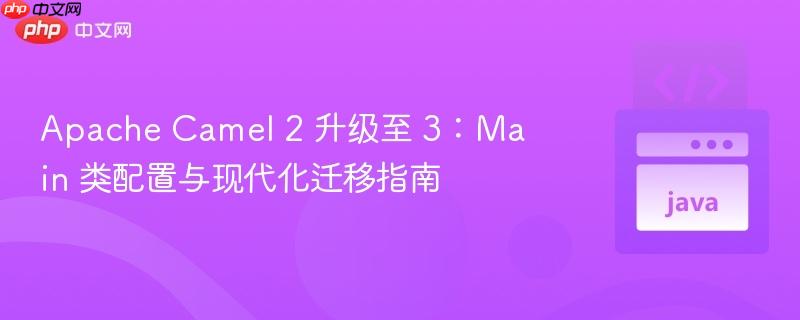
在将Apache Camel项目从2.x版本升级到3.x版本时,开发者常会遇到一些API和配置上的变化。其中一个常见的问题是,在Camel 2中用于加载Spring应用上下文的Main.setApplicationContextUri()方法在升级到Camel 3后似乎“消失”了。这主要是因为Camel 3对Spring集成模块进行了重构和拆分。本文将详细阐述这一变化的原因,并提供两种解决此问题的方案,包括继续使用Spring XML配置以及更推荐的现代化Java配置方式。
在Camel 2中,org.apache.camel.Main类通常直接提供了与Spring框架集成的能力,例如通过setApplicationContextUri()方法加载Spring XML配置文件。然而,从Camel 3.2版本开始,为了更好地模块化和解耦,将Main类中与Spring ApplicationContext相关的支持功能迁移到了独立的camel-spring-main模块中。这意味着,如果你在Camel 3项目中仍然希望通过Main类来加载Spring XML配置文件,你需要显式地引入这个新的模块,并使用其中提供的Main类。
如果你希望在升级到Camel 3后仍然沿用现有的camel-context.xml等Spring XML配置文件来定义Camel上下文和路由,那么你需要引入camel-spring-main依赖,并使用其提供的Main类。
首先,确保你的pom.xml文件中包含了camel-spring-main的依赖。请注意,Camel 3.14.x 是支持 Java 8 的最新版本之一,因此以下示例将基于此版本。
<dependency>
<groupId>org.apache.camel</groupId>
<artifactId>camel-spring-main</artifactId>
<version>3.14.6</version> <!-- 或你正在使用的Camel 3.x版本 -->
</dependency>
<dependency>
<groupId>org.apache.camel</groupId>
<artifactId>camel-spring</artifactId> <!-- 如果你的XML使用了camel-spring命名空间,可能也需要 -->
<version>3.14.6</version>
</dependency>
<dependency>
<groupId>org.springframework</groupId>
<artifactId>spring-context</artifactId>
<version>5.3.20</version> <!-- 确保Spring版本与Camel 3.14.x兼容 -->
</dependency>引入依赖后,你就可以使用org.apache.camel.spring.Main类来加载你的Spring XML配置文件了。这个类提供了与Camel 2中Main.setApplicationContextUri()类似的功能。
import org.apache.camel.spring.Main; // 注意这里是 camel-spring-main 包下的 Main
public class MySpringCamelApp {
public static void main(String[] args) throws Exception {
Main main = new Main();
// 设置要加载的Spring应用上下文配置文件
main.setApplicationContextUri("classpath:camel-context.xml");
// 如果有多个配置文件,可以设置多个
// main.setApplicationContextUri("classpath:app-context.xml,classpath:camel-context.xml");
// 启动Camel
main.run();
}
}注意事项:
鉴于XML配置的复杂性和维护成本,Apache Camel 3强烈推荐使用Java代码、注解和外部属性文件进行配置。这不仅简化了配置,还提供了更好的类型安全和IDE支持。
假设你有一个camel-context.xml如下:
<beans xmlns="http://www.springframework.org/schema/beans"
xmlns:context="http://www.springframework.org/schema/context"
xmlns:xsi="http://www.w3.org/2001/XMLSchema-instance"
xmlns:camel="http://camel.apache.org/schema/spring"
xsi:schemaLocation="
http://www.springframework.org/schema/beans http://www.springframework.org/schema/beans/spring-beans.xsd
http://www.springframework.org/schema/context http://www.springframework.org/schema/context/spring-context.xsd
http://camel.apache.org/schema/spring http://camel.apache.org/schema/spring/camel-spring.xsd
">
<camel:camelContext id="camel" trace="false">
<camel:propertyPlaceholder id="queriesConfig" location="lib/queries.properties" />
<camel:package>com.blah.listener</camel:package>
</camel:camelContext>
<bean id="sqlComponent" class="org.apache.camel.component.sql.SqlComponent">
<property name="dataSource" ref="dataSource" />
</bean>
<bean id="bean1" class="com.foo.OurThing" />
<bean id="bean2" class="com.bar.OtherThing" />
<!-- dataSource bean 假设在 app-context.xml 或其他地方定义 -->
</beans>迁移步骤:
移除 camel-context.xml 引用: 如果你的app-context.xml引用了camel-context.xml,请移除该引用。camel-context.xml文件本身也可以被移除。
创建 Camel Java 配置类: 创建一个Spring配置类,用于定义SpringCamelContext和相关的Camel Bean。
import org.apache.camel.CamelContext;
import org.apache.camel.spring.SpringCamelContext;
import org.apache.camel.component.sql.SqlComponent;
import org.springframework.context.ApplicationContext;
import org.springframework.context.annotation.Bean;
import org.springframework.context.annotation.Configuration;
import org.springframework.context.annotation.ComponentScan;
import org.springframework.context.annotation.PropertySource;
import org.springframework.beans.factory.annotation.Autowired;
import org.springframework.core.env.Environment;
import javax.sql.DataSource; // 假设你的DataSource已定义
@Configuration
@ComponentScan(basePackages = "com.blah.listener") // 替代 <camel:package>
@PropertySource("classpath:lib/queries.properties") // 替代 <camel:propertyPlaceholder>
public class CamelConfig {
@Autowired
private ApplicationContext applicationContext;
@Autowired
private Environment env; // 用于访问 properties 文件中的属性
// 假设 dataSource bean 已在其他Spring配置中定义
@Autowired
private DataSource dataSource;
@Bean
public CamelContext camelContext() throws Exception {
SpringCamelContext camelContext = new SpringCamelContext(applicationContext);
camelContext.setName("camel"); // 设置CamelContext ID
camelContext.setTracing(false); // 对应 trace="false"
// 如果需要手动添加路由,可以在这里添加
// camelContext.addRoutes(new MyRouteBuilder());
// 替代 <camel:propertyPlaceholder>,Spring会自动处理 @PropertySource
// 如果需要将 properties 文件中的属性注入到 Camel Context,可以使用 PropertyConfigurer
// 但通常,通过Spring的Environment或@Value注解直接在Java路由中使用更方便。
return camelContext;
}
// 替代 <bean id="sqlComponent" ...>
@Bean(name = "sqlComponent")
public SqlComponent sqlComponent() {
SqlComponent sql = new SqlComponent();
sql.setDataSource(dataSource);
return sql;
}
// 替代 <bean id="bean1" ...>
@Bean(name = "bean1")
public com.foo.OurThing bean1() {
return new com.foo.OurThing();
}
// 替代 <bean id="bean2" ...>
@Bean(name = "bean2")
public com.bar.OtherThing bean2() {
return new com.bar.OtherThing();
}
}创建 Java 路由类: 对于<camel:package>com.blah.listener</camel:package>,Spring的@ComponentScan会自动扫描指定包下的RouteBuilder实现类,并将其注册到CamelContext中。
package com.blah.listener;
import org.apache.camel.builder.RouteBuilder;
import org.springframework.stereotype.Component;
import org.springframework.beans.factory.annotation.Value; // 用于访问属性
@Component // 确保Spring能够发现并注册这个路由
public class MyRouteBuilder extends RouteBuilder {
@Value("${my.queue.name}") // 从 lib/queries.properties 或其他属性源获取
private String queueName;
@Override
public void configure() throws Exception {
// 示例路由,假设你的 queries.properties 中有 my.queue.name=myQueue
from("timer:hello?period=5s")
.log("Hello from Camel! Queue name: ${body}")
.to("direct:processMessage");
from("direct:processMessage")
.log("Processing message for queue: " + queueName)
.to("mock:output");
}
}创建 lib/queries.properties 文件: 在src/main/resources/lib/queries.properties(或你的类路径下的相应位置)创建文件:
my.queue.name=myQueueFromProperties
启动应用: 如果你使用Spring Boot,只需运行主应用类即可。如果是非Spring Boot应用,你需要使用AnnotationConfigApplicationContext来加载你的Java配置。
import org.springframework.context.annotation.AnnotationConfigApplicationContext;
public class MyJavaCamelApp {
public static void main(String[] args) {
// 加载Spring配置类
AnnotationConfigApplicationContext context = new AnnotationConfigApplicationContext(CamelConfig.class);
context.start(); // 启动Spring上下文,CamelContext也会随之启动
// 保持应用运行,直到手动关闭
// 或者通过其他机制(如Spring Boot的WebServer)保持运行
Runtime.getRuntime().addShutdownHook(new Thread(context::close));
}
}从Apache Camel 2升级到3,Main.setApplicationContextUri()方法的变化是Spring集成模块重构的结果。对于希望继续使用Spring XML配置的用户,引入camel-spring-main模块并使用org.apache.camel.spring.Main是直接的解决方案。然而,更推荐的现代化方法是完全拥抱Java配置、注解和外部属性文件,这不仅能解决当前问题,还能显著提升代码的清晰度、可维护性和开发效率。通过将XML配置逐步迁移到Java,你的Camel应用将更加适应未来的开发趋势和云原生环境。
以上就是Apache Camel 2 升级至 3:Main 类配置与现代化迁移指南的详细内容,更多请关注php中文网其它相关文章!

每个人都需要一台速度更快、更稳定的 PC。随着时间的推移,垃圾文件、旧注册表数据和不必要的后台进程会占用资源并降低性能。幸运的是,许多工具可以让 Windows 保持平稳运行。

Copyright 2014-2025 https://www.php.cn/ All Rights Reserved | php.cn | 湘ICP备2023035733号